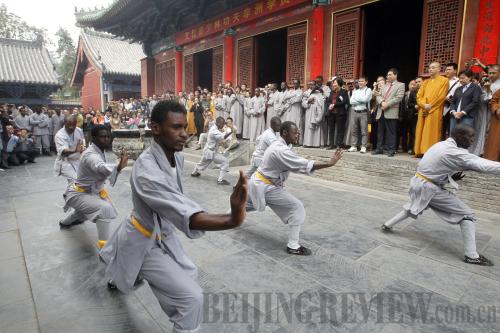|
 |
|
DISCIPLES: The African students give a kungfu performance during their graduation ceremony on December 18, 2013 (CFP) |
Shaolin students
Dawit Terefe is an Ethiopian kungfu actor who has practiced martial arts for more than two decades. Before coming to Shaolin, Terefe expected lessons from the program on higher-level techniques like faster moves or more accurate strikes. He was right, but that's only half of it. Another important lesson the African students learned at Shaolin was how to best utilize rest.
Every Wednesday afternoon, there was a one-hour meditation class. Students sat in contemplation for 40 minutes, learning how to attain spiritual peace.
Meditation is an important element of Chan (Zen) Buddhism. Although the foundation for modern kungfu began in 527 when the Indian monk Bodhidharma arrived at the Shaolin Temple and created the 18 Buddhist Fists. The Shaolin Temple is also the place where the Chan doctrines were first preached in China in 495.
"After coming to Shaolin, I realized that it's more than just fighting techniques, and has a profound religious background," said Peter Zanang Kazah. "Now I'm ready to learn the real meaning of the kungfu and its culture."
"Some people asked me how many people are learning Shaolin kungfu around the world," Abbot Shi Yongxin said. "I would say millions, or even more than that."
Since a German became the first foreign disciple in 1989, the Shaolin Temple has been promoting its martial arts and culture abroad by setting up overseas training centers. Every year hundreds of people still come from all around the world to the temple in Henan Province, to spend several months or even years on a unique experience, or to achieve an advanced level of kungfu. They know there is something one can never find outside of the temple.
Here, all the students, Chinese and foreigners, are required to act like real Shaolin disciples. They dress in grey robes and have vegetarian dinners complete with rituals before eating. They also join the monks' morning classes every Monday.
Abbot Shi Yongxin believes that Shaolin kungfu not only strengthens a person's body, but also spreads a lifestyle that allows followers to obtain inner peace. He told his African disciples to take the Shaolin Temple as their "second and spiritual home."
"The Shaolin Temple is a good place where I met people with different religions and cultural backgrounds," said Emezue. "I'm sure that I will become a new person when I'm back home. The things I learned at Shaolin are priceless."
Email us at: liuyunyun@bjreview.com | 